Underwater museums and artificial reefs are not the first things that come to mind when planning a diving trip. However, there are a large number of them around the world and little by little, for different reasons, they are increasing in popularity.
These sites have very particular characteristics and in some cases great ecological importance. They are also an excellent option for diving in areas where the tourist attraction was not so interesting before their appearance. They make an important contribution to the economy of the localities in which they are located.
In this article we present a brief summary of some of the most interesting underwater museums and artificial reefs around the world.
Some of them are famous, while others remain little explored.
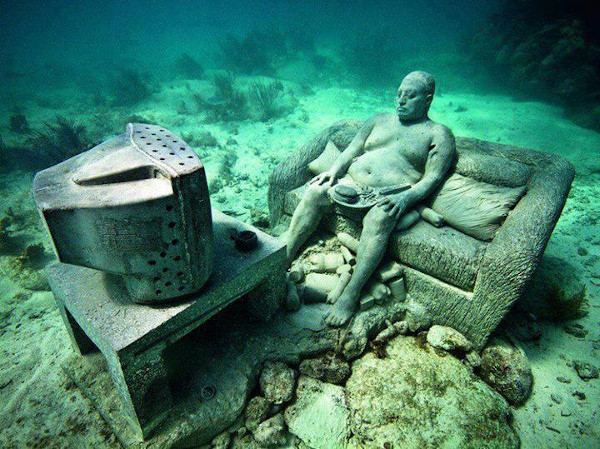
What is an underwater museum?
The first thing we want to clarify is that an underwater museum and an artificial reef are not the same, although they are very similar.
In order for us to be able to speak of an artificial museum, there must be objects that in themselves have a cultural or scientific value or that, due to their own beauty, can be considered a tourist attraction.
Of course over time many organisms are attracted to the shelter provided by the different structures and an artificial reef will almost certainly begin to form.
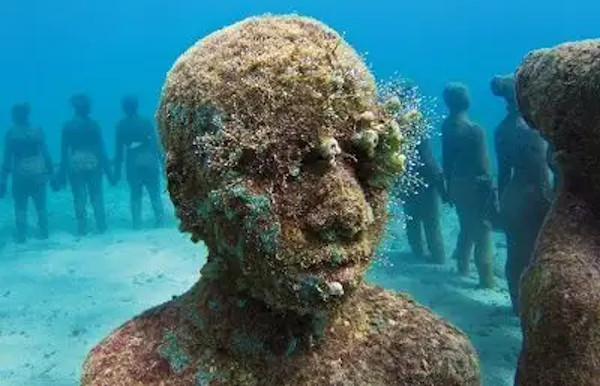
What is an artificial reef?
An artificial reef is one that man creates by placing a structure below the surface of the water, often at a shallow depth.
It can be a sunken ship, concrete structures, or a metal underwater museum.
I consider it important to mention that there are 4 types of reefs: coral, rocky, mixed and artificial.
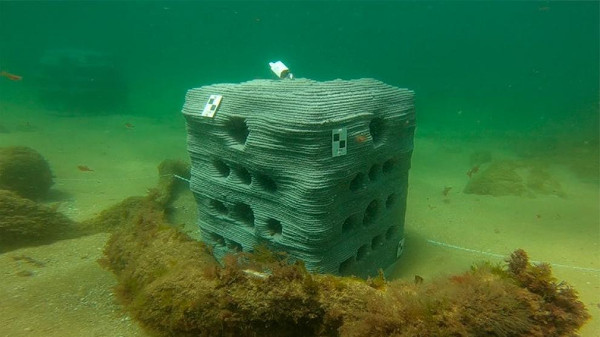
Why do humans create artificial reefs?
There are important ecological and socio-economic reasons why humans are creating artificial reefs:
a-Artificial reefs help restore natural reefs already affected by negative factors such as increased water temperatures, pollution, sedimentation or even a strong storm.
b- Artificial reefs serve to expand existing healthy reefs in sites that already have suitable conditions for their development.
c- Artificial reefs creates new ecosystems in places where there was only a poor desert bottom.
This due they provide refuge for small species of fish and coral larvae. Which in turn provide food and other elements necessary for biodiversity and a productive ocean.
d- By attracting marine biodiversity, people create new diving and fishing sites which in turn helps activate local economies that live off tourism.
e-Artificial reefs promote environmental education and help create awareness.
For example, in some of these places, those who plant the reefs are volunteers.
Volunteers who can participate in citizen science programs and learn more about the different processes.
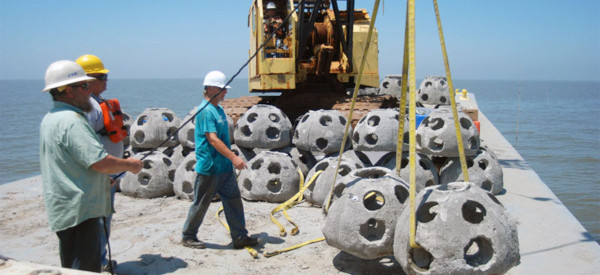
Why do people create underwater museums?
As we said before, an underwater museum has a very good chance of becoming an artificial reef soon.
It has the same advantages of the artificial reef and also has a unique beauty since it is commonly made up of sculptures which are found several meters deep. A real attraction for divers and swimmers.
Where can an artificial reef be planted?
The creation of an artificial reef must be based on scientific studies that determine that the site to be used is adequate.
The organisms that adhere to the structures require very specific conditions in order to develop and therefore variables such as the substrate, water temperature, depth and water quality, among others, must be taken into account.
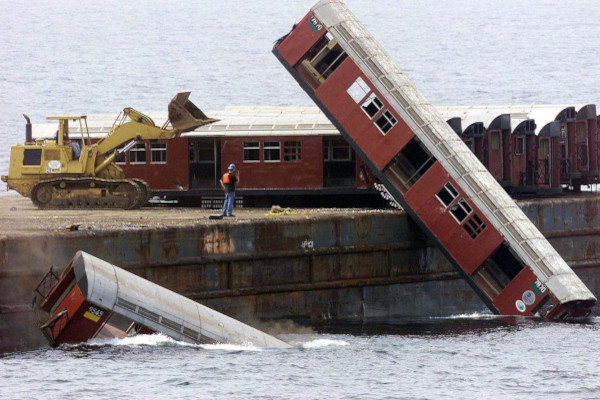
Artificial Reef in progress – Gulf of Thailand
It is also very important to select the materials that are going to be used in such a way that in the long term they do not become a pollution problem instead of a positive action.
There have been different cases in which people with good intentions have sunk objects in order to create a reef and in a short time the consequences have been very negative.
For example, in 1972 a professor at the University of Fort Lauderdale in Florida had the idea of sinking two million old tires two kilometers from the coast in order to create the largest artificial reef in the world.
Unfortunately, things did not go as planned and instead of attracting marine life, the toxic substances that the tires gave off ended up killing everything around them.
Some of the ties that held the tires together came loose and thousands of tires drifted, injuring turtles and other animals and polluting nearby beaches.
In 2007, the Florida Department of Environmental Protection with the help of the United States Army began the cleanup, however, to this day the damage to the environment still persists.
What is known as the Osborne reef is a clear example of how the good intention of creating an artificial reef without the knowledge and support of scientific studies can end up producing an environmental disaster.
Are the shipwrecks artificial reefs?
Yes. The vast majority of shipwrecks in the sea become artificial reefs. Shipwrecks can be found all over the world and are quickly becoming sites of great scenic beauty and immeasurable biological wealth.
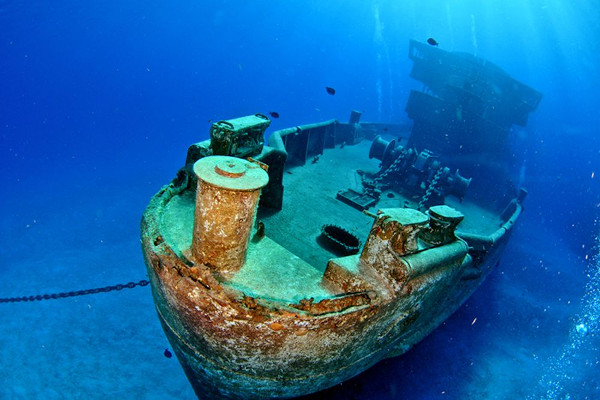
Serving as a refuge for small fish and having surfaces to which other organisms can adhere, the shipwrecks become ecosystems after a few days.
Fishes and divers like shipwrecks that much that in recent decades some ships have intentionally sunk in order to create this type of artificial reef.
However, it is important to remember that whoever makes them must prepare the place in advance so as not to cause a disgrace to the environment and be safe for divers.
Be aware about cleaning from toxic waste such oils.
They must remove all electronic components and in some cases they need to open larger entry and exit holes to make them safer when receiving divers inside.
It is also logical to calculate the depth and the position at which the ship will lie once it lands on the ocean floor.
That was the case of the ship LADY LUCK sunk in Florida. They prepared the ship to receive divers by making it safer and placing some casino-themed elements to provide a very special experience for their visitors.
Video-Best Wreck Dive Florida tour the Lady Luck Wreck
Underwater museums around the world
Now that you know what an underwater museum is, we bring you some of the most interesting in the world.
So that you can take it into account when planning your next diving trip.
Underwater Museum of Art (MUSA) in Cancun, Mexico
This museum is one of the biggest aquatic attractions in Cancun. It is located in the Mexican Caribbean near Isla Mujeres. Its main objective is to reduce the visit to the natural reefs in the area. It was inaugurated in 2009 and has more than 500 sculptures, being considered the world’s largest collection of underwater art. The greatest exponent of MUSA is Jason deCaires Taylor.
The works that are exhibited in the MUSA have an ecological conceptualization. Therefore the materials chosen for their construction do not harm the ecosystem.
In addition, the sculptures have holes of different sizes to attract different types of fish.
To visit this museum there are three options: With diving equipment, snorkeling or aboard a glass-bottom boat.
Companies that offer these services depart from Cancun and the duration of the tours is approximately 5 hours.
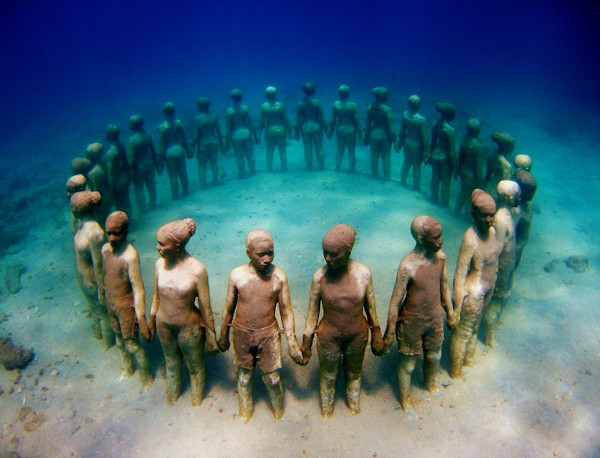
Check our article: 7 great diving destinations
Ocean Atlas in Nassau, Bahamas
This is a single statue of more than 5 meters high and 60,000 kilos of weight built of concrete.
It is located at the western end of Nassau Island, less than 1 kilometer from the coast and submerged at a depth of 5 meters.
The statue is the representation of a girl holding the weight of the sea., Which has an important meaning since it symbolizes the loads that the ocean bears due to human action.
Human action such as pollution and global warming and makes a direct relationship with the affectation that the oceans will suffer. future generations for these problems.
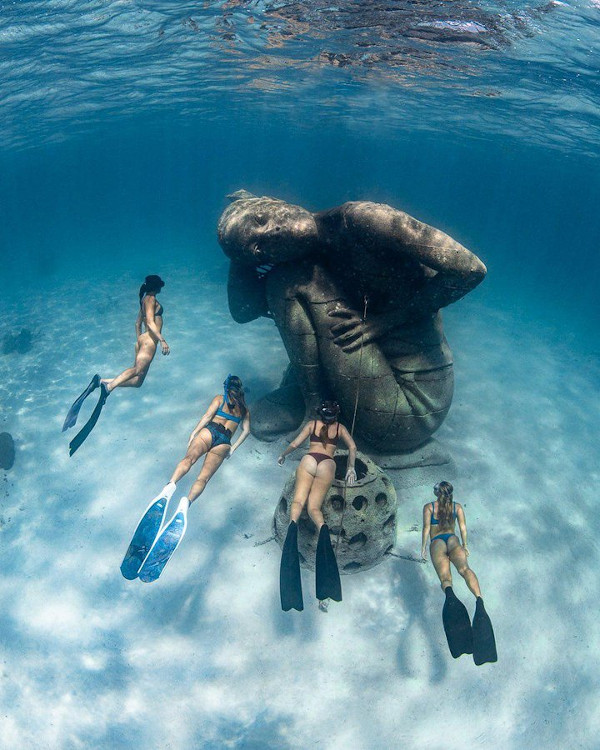
The Ocean Atlas statue was built in 2014 by the artist Jason de Caires Taylor who has developed an innovative technique using neutral PH cement which does not damage or acidify the water and allows the adherence of organisms such as corals and sponges.
Due to its large size, the statue had to be made in several pieces and joined underwater with the help of divers.
A red flag and a solar mirror have been placed on the surface of the water, since during the lowest tides part of the statue rises almost a meter.
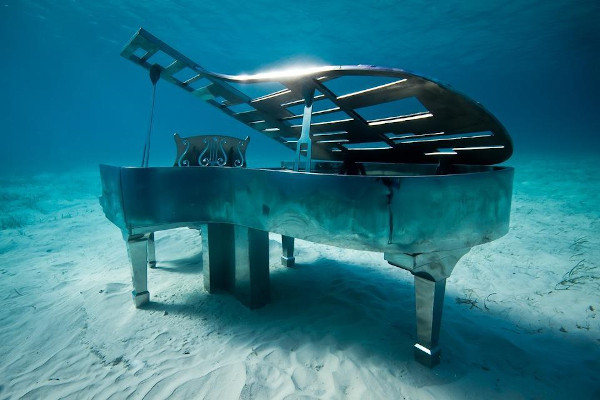
Underwater Museum of Art in Florida, United States
In 2018 the Cultural Arts Alliance (CAA) and the South Walton Artificial Reef Association (SWARA) joined forces to create the first permanent underwater sculpture museum in North America.
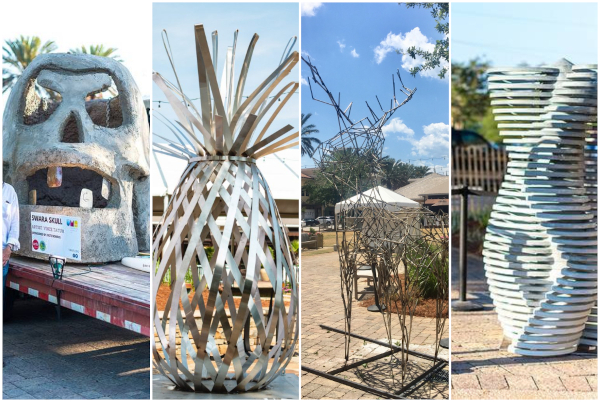
It is located approximately 0.8 miles offshore from Grayton Beach and lies 18 meters deep.
The Museum of Underwater Art (UMA) is part of the Cultural Arts Alliance’s Art in Public Spaces Program and contributes to the South Walton Artificial Reef Association’s (SWARA) mission to create marine ecosystems and expand fishing populations to at the same time that it provides a creative, cultural, educational and economic improvement.
The site seeks to unite conservation with art, building marine life sanctuaries off the coast.
As well as providing a valuable dive site for visitors, the sculptures have been designed and selected with their suitability as a marine habitat in mind.
Even when divers don’t visit the site, the Underwater Museum of Art boasts many other visitors, including schools of fish, groupers, sea turtles and dolphins.
The CAA plans to select more artists and add more pieces to the underwater collection on a regular basis.
Admission to the museum is free and you don’t need reservation. However, there is a fee to enter the state park. The museum is for divers only.
Coralorium, Fairmont Hotel, Sirru Fen Fushi, Maldives
Work of the artist Jason DeCaires Taylor this beautiful work is located in the largest lagoon of the Shaviyani Atoll. This work of art consists of a semi-submerged steel cube within which different human figures stand out.
You can reach this attraction by sailing or swimming from the shore.
It is Taylor’s largest and most complex structure to date as it weighs 180 tonnes, was manufactured in the UK and assembled in the Maldives.
This work became news during the last electoral campaign, when government representatives arrived and took the figures of people out of the water and destroyed them.
This is because in the religion of Islam, they don’t allow images of people or animals.
International public opinion was upset and rebuked the conservative Muslim government.
Taking into account the electoral panorama this was apparently a purely political game.
The facility has now been restored and now houses coral structures.
Undoubtedly one of the best works of the artist Jason DeCaires Taylor.
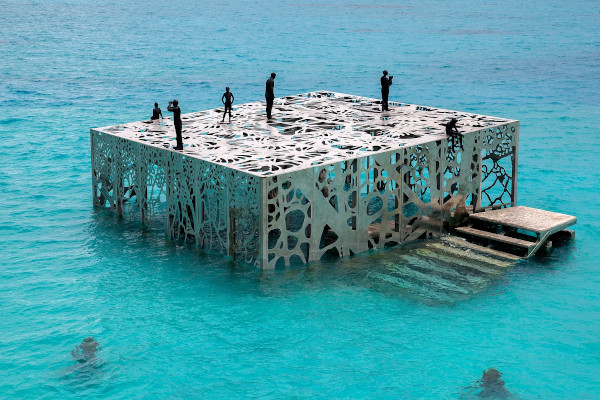
Museum of Underwater Art, MOUA, Australia
The work of artist artist Jason DeCaires Taylor is the first and only aquatic art museum in the southern hemisphere.
It was created in 2019 and is located on the Great Barrier Reef in Townsville, Australia.
The main objective of this museum is the conservation, restoration and education of the reef.
These are massive structures and sculptures shaped like an underwater coral greenhouse, giving rise to its name “The Coral Greenhouse”.
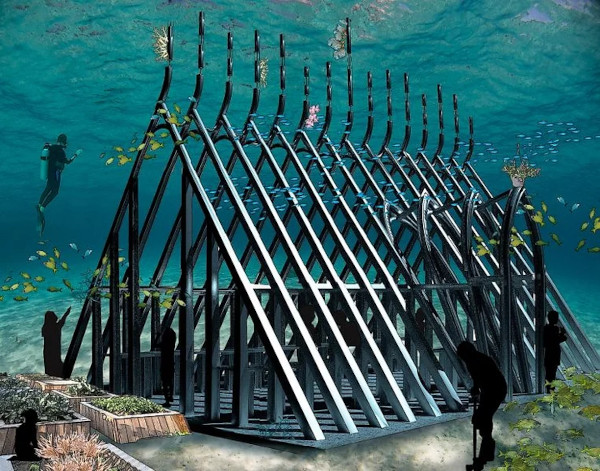
The Green House by artist Jason DeCaires Taylor
The site is adapted for snorkeling and diving. Inside the structure are 20 statues with the name of “guardians of the reefs”.
These statues are inspired by local school children who in turn help care for the project.
The “mermaid of the ocean” is the only piece in the entire museum that you can see outside of the water. He is based on an indigenous girl from Wulgurukaba named Takoda Johnson.
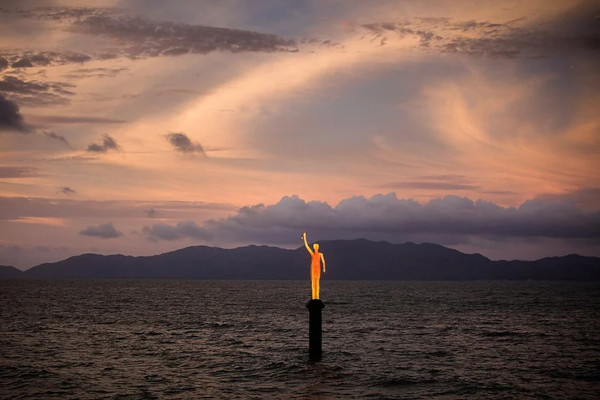
The sculpture reacts to changing water temperatures and changes color from blue to dark red as LED lights illuminates it.
Underwater museum in Cannes, France
This underwater museum was created in 2021 and is made up of 6 works by Artist Jason deCaires Taylor. It is located off the coast of Cannes near the island of Sainte-Marguerite. It was in this museum that the artist from Caires first built sculptures in the Mediterranean Sea.
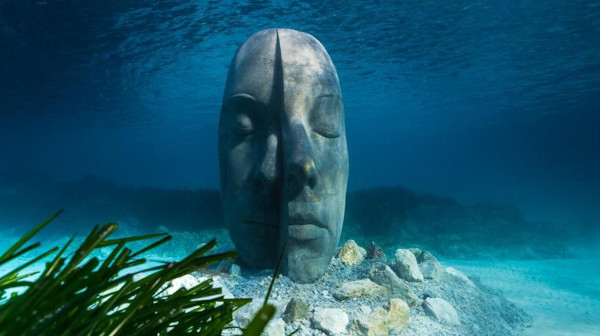
The representation consists of 6 human faces with a height of approximately 2 mts each and a weight of 10 tons.
The faces rest on the white sand between the seagrass beds and are easy to see due to the clarity of the water.
The human faces have two sides. One side of the face represents the ocean and the other its fragility and aims to make visitors aware of the importance and need to protect the oceans and seas.
It is quite easy to get to the exhibition. As they are located at a depth of two to three meters, so visitors to this unusual museum only need to put on a pair of snorkeling goggles.
Submerged statues -The Tide, the River Thames, London, United Kingdom
This is another of the works by artist Jason deCaires Taylor and it exists since 2015 on the banks of the River Thames.
You can see the statues out of the water at low tide and submerge at high tide to a depth of 8 meters.
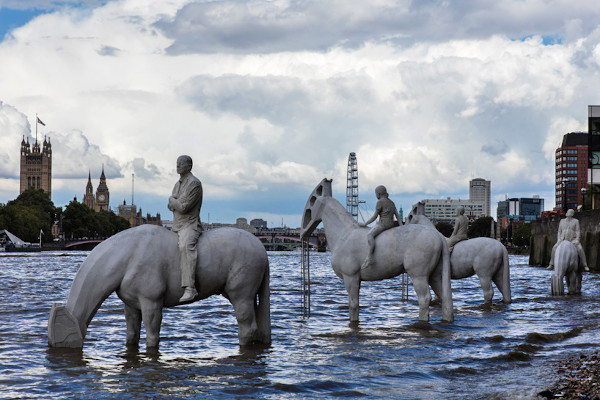
Sculptures in the shape of horsemen riding horses-work by artist Jason deCaires Taylor
The work consists of 4 sculptures in the shape of horsemen riding horses which represent the four horsemen of the apocalypse and send a strong message to those who observe them.
They make a call to pay attention to climate change that stalks us more every day.
This work is a good example of how not all underwater museums are necessarily artificial reefs.
Underwater Museum in Cape Tarkhankut Crimea, Ukraine
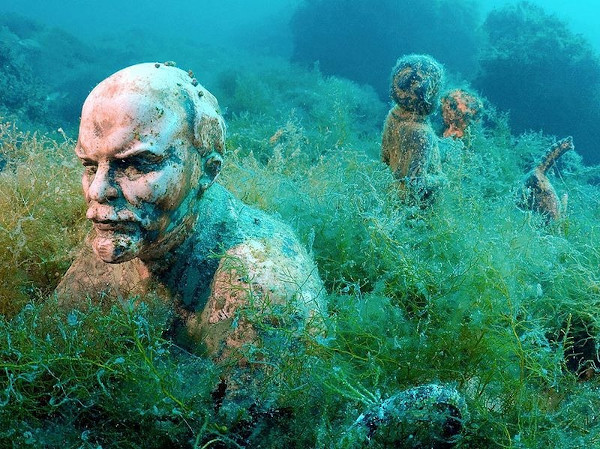
This museum started in 1992 with its creator the diver Vladimir Broumenskyy just a few hundred meters off the coast of Tarkhankut.
After the collapse of the Soviet Union dozens of statues and busts of communist leaders torned down.
They took some of these broken busts to Moscow, to the “Park of Fallen Heroes”, and took others with Vladimir Broumenskyy to Cape Tarhankut, where he decided to sink them into the sea.
The museum has since grown in popularity and number of pieces. The museum has a large number of annual visitors.
You can see more than 50 statues, among which those of Lenin, Marx and Stalin stand out, as well as replicas of some of the world’s great tourist attractions, such as the Eiffel Tower or Tower Bridge in London.
Baia Underwater Park, Italy
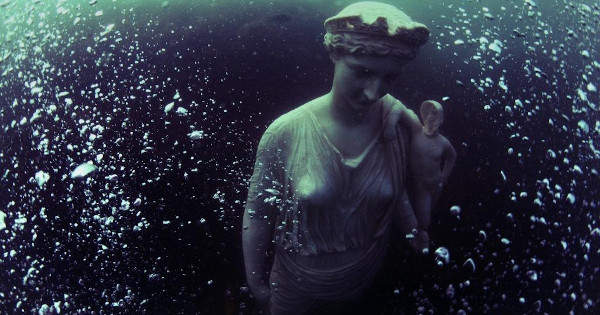
Baia Underwater Park – Italy
This underwater park is very special since, unlike others, the creator was not a sculptor or artist, but rather it is a true submerged Roman city.
It is located very close to the coast and only 4 meters deep.
They first discoveried this sit around the 1920s, but it was not until 1960 that they carried underwater investigations.
In 2007, they got permission for the exploitation of tourism.
This was an area of great wealth during the Roman Empire so it was like “Las Vegas” of Rome and was home to the Western Imperial Fleet.
The main problem was that this area sits on a pocket of magma of variable volume that generates seismic movements so the ground can rise or fall.
In this case, a subsidence and a collapse caused that submerged all the buildings.
You can visit the archaeological park with glass-bottom boats, snorkeling or diving with equipment.
Nexus, Oslo Norway
Twelve sculptures located in the waters of the Oslo fjord form Nexus.
It exists since 2018. Created by the artist Jason deCaires Taylor.
The main objective of the center is to encourage children to explore art and nature.The installation’s design attracts young people to nature and arouse their curiosity.
Students supervise the changes that the structures undergo as they are colonized and inhabited by marine organisms.
Sculptures try to represent the connection that exists between the land and the sea.
Two of the figures representing a father and daughter holding hands are on the floating dock and he is looking at the other ten figures.
The floating figures connected to each other on the sea floor through what looks like a stainless steel “umbilical cord”, as they remind us that life on earth began in the ocean and that we must stay connected to survive.
The figures also create a connection between nature and art.
We hope that over time this structure will attract marine life and help regenerate the marine ecosystem.
The appearance of the fjord changes throughout the seasons. When looking at the works from below, the different layers of water create an effect of light filters, also changing the interpretation.
Beneath the ice in winter, algae in the water create color patterns reminiscent of the Northern Lights.
Snorkelers and scuba divers can appreciate the works of art with a glass-bottom kayak.
Divers often create holes in the ice during winter time so experience divers can visit it.
Underwater Museum, Atlantic Museum Lanzarote, Spain
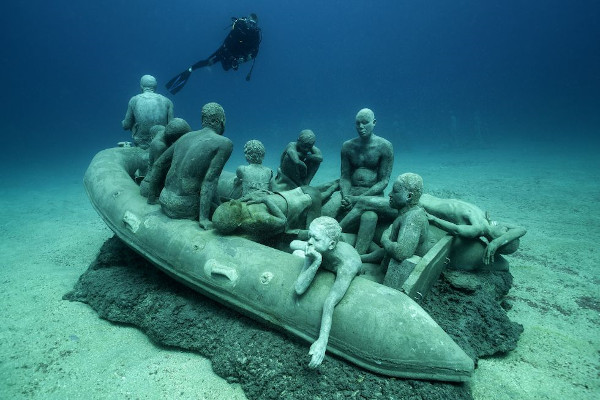
Atlantic museum Lanzarote
This museum is located in the waters of the southern coast of Lanzarote, just 300 meters from the Marina Rubicon.
It is the first museum of its kind in all of Europe.The creator was artist Jason deCaires Taylor in the year of 2016.
It is located in the UNESCO World Biosphere Reserve. In it you can see a total of 300 human figures.
Like most of Caires’s works, he himself created this museum thinking of a place of conservation, preservation and education of the marine environment and nature.
The sculptures have real size. The sculptures show people performing everyday acts. You can see how each person has unique characteristics.
It also features a group of characters that are part human and part cactus art. This art´s name is the Hybrid Garden.
Thanks to its construction, many organisms are recovering, from both flora and fauna.
You can also see banks of barracudas, sardines, sea sponges, octopuses and even angel sharks, among other species.
You can get to the Underwater Museum only by boat, departing from the port of Playa Blanca.
Normally, people take advantage of the boat transfer to do two dives, one in the Museum and another in one of the best places in Playa Blanca.
Underwater Museum, MUSAN, Ayia Napa, Cyprus
This is another of the works of artist Jason deCaires Taylor who has designed 93 works of art located less than 200 meters from Pernera beach.
As with most of his works, the artist seeks to raise awareness and foster a rapprochement between people, the marine environment and its conservation and protection.
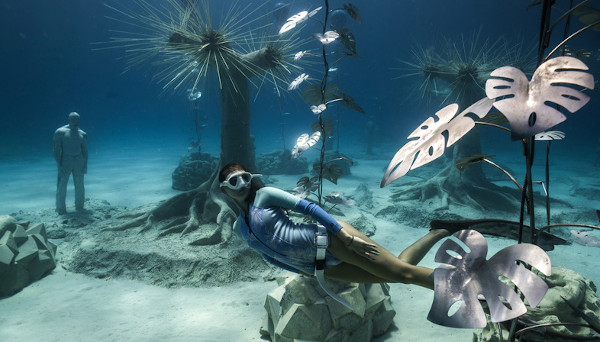
Underwater Museum – MUSAN – Ayia Napa – Cyprus
Visitors can access with diving or snorkeling equipment and with the help of a map explore the 1700 square meters of seabed where the different works are located.
The sculptures seek to highlight the history of Ayia Napa as a dynamic and modern cultural complex, trying to boost eco-tourism through the exploration of the legacy of the region and its rich natural heritage.
The works represent children and adults playing.
According to Jason deCaires Taylor, “they remind us of our need for the natural world as a place to explore, discover and fire our imaginations, as well as refreshing us with the idea that we ourselves are natural”.
Molinere Underwater Sculpture Park, Grenada, West Indies
This Underwater Sculpture Park is a collection of underwater contemporary art that in turn has a strong ecological motivation located in the Caribbean Sea off the west coast of Grenada.
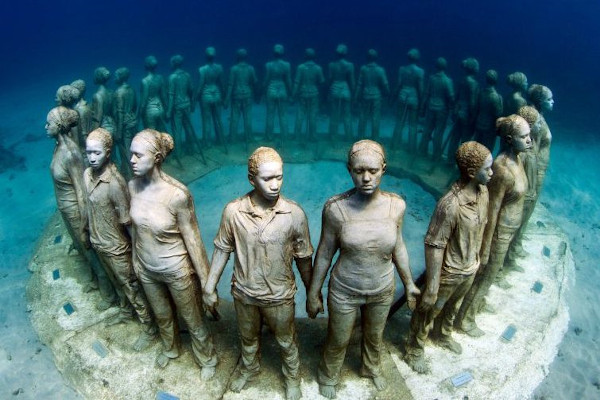
Molinere Underwater Sculpture Park – Grenada – West Indies
Sculptor Jason deCaires Taylor created it in 2006.
The main objective of the artist was to engage the local population in the underwater environment around them using his artwork, thus drawing on representations of the local community.
He installed cement figures on the bottom of the sea, which mostly consist of a variety of human forms, from solitary individuals to a circle of children holding hands, looking towards the sea currents from where the resources and nutrients come in a beautiful metaphor that we prosper thanks to what we absorb.
As part of this work you can also find a man sitting at a desk with a typewriter.
Acording to National Geographic it ranks 25th of the modern wonders of the world.
It consists of a total of 75 works distributed among coral and rock formations.
You can easily access to it at a depth of 5 to 8 meters for divers and snorkelers.
Other way of reaching this beautiful site is by boat (including a glass-bottom boat) directly from the capital St. George and from Grand Anse.
The museum is a response to the destruction of the reef that occurred in 2004 during Hurricane Ivan.
Located in the Molinere Beauséjour Marine Protected Area.
Statues of Bask Gili Meno, Indonesia
The artist Jason DeCaires Taylor created this work in 2007, which consists of 48 human figures placed four meters deep.
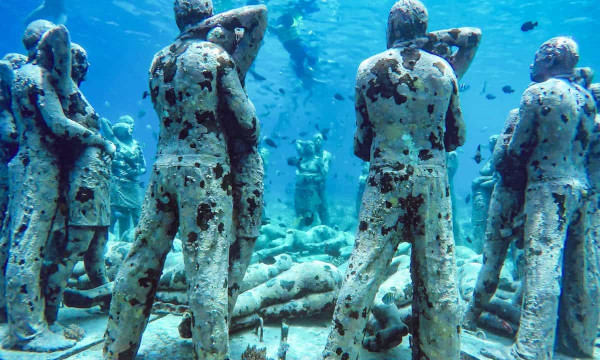
They are located in the Gili Islands which are three small islands off the coast of Lombok in Indonesia.
Just an hour or two by boat from Bali.
Described as “hauntingly beautiful”, the Gili Meno statues have quickly become a major attraction for scuba divers and freedivers.
Symbolizing life and continuity since all the statues are located in a circle.
They are in pairs embracing each other.
Something that makes the sculptures really special is that they are all based on real people.
The Gili Islands in Indonesia are famous for their crystal clear waters, spectacular coral formations, and diverse marine life.
What really attracts visitors are the good conditions for diving, the colorful reefs and the large number of sea turtles and other animals that inhabit the islands.
If you are looking for a unique experience, make sure you visit the Gili Meno statues.
Video-MOUA Museo de Arte Subacuático, Queenland Australia
The Musician underwater sculpture in Musha Cay, Exumas, Bahamas
The Musician is a sculpture that the artist Jason DeCaires Taylor made independently in 2011.
The work has two parts: a full-scale mermaid built with neutral PH cement and a replica of a classic piano built with steel stainless.
As the divers approach, the piano reproduces a soft classical music sound similar to that of a whale or dolphin.
You will meet the sculpture only 4 meters deep.
Punta Leona Underwater Museum, Costa Rica
Costa Ricans are not far behind in the development of underwater museums and artificial reefs.
Although we do not have any work by Jason deCaires Taylor, we were the first to have an underwater museum in Central America.
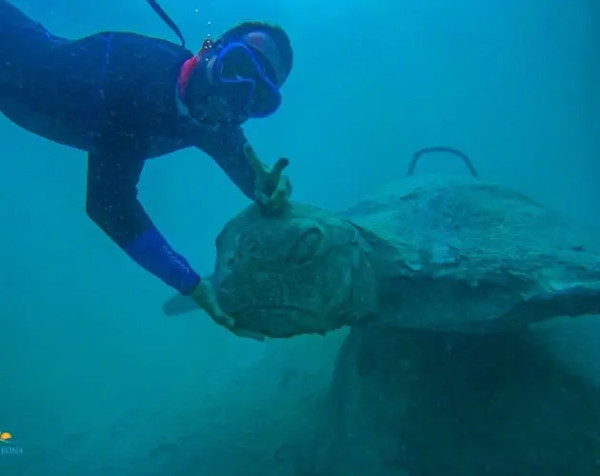
Punta Leona Underwater museum
Where is the Punta Leona Museum located?
This museum is located in Punta Leona in the central Pacific of Costa Rica.
That means 50 meters from Playa Blanca and only two meters deep.
What began in 2020 with the placement of 30 “Reef Balls” to create artificial reefs gave rise to the placement of different statues.
Statues that today visitors can enjoy both with diving equipment and snorkeling.
See more pictures here
What to see in Punta Leona underwater Museum?
It has 3 statues. El Cacique Garabito that represents our aboriginal people. And it is an important figure in the town that also bears his name.
A Kemp’s ridley sea turtle and a manta ray that represent the marine biodiversity that inhabits our country.
The talented Costa Rican sculptor Fabio Brenes Morales. As well known artist in our country for his work in wood is the one who led this project.
Students from different universities in Costa Rica and the United States prarticipated in the construction of this museum.
“The museum is a very visual, regenerative and, above all, living experience. Since art interacts with nature and together they will evolve over time.
We want it to be an accessible project. And we are sure that it will bring the public closer to the marine environment.
Closer to the conservation and protection of this habitat”, said César Vargas.
Another interesting fact is that admission is free since any one can get there from the beach.
We Costa Ricans are proud of the importance that our country gives to nature. Which through tourism has become one of the central axes of our economy.
Despite the fact that we have not always managed to protect what belongs to us.
We continue to fight to show the whole world that with projects like this and with good ideas, we will succeed.
Underwater museums and artificial reefs. Conclusions.
Throughout this article we were able to summarize some of the most beautiful underwater museums in the world.
Also their importance from two points of view became clear:
1) The conservation of the species and ecosystems that inhabit them once they become artificial reefs and
2) the various messages they convey, most of which are pro-conservation. It express the important connection between humans and the ocean.
About Jason deCaires Taylor
Born in the United Kingdom on August 12, 1974, he is the artist who has made the most contributions to the creation of underwater museums and works of art around the world.
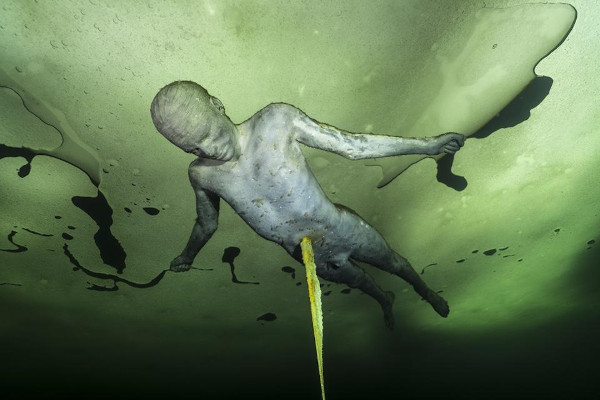
He integrates his qualities as a sculptor, conservationist, plastic artist, underwater photographer and diving instructor.
That is to achieve such a valuable contribution to humanity.
His work in Granada ranks 25th among the Wonders of the World by National Geographic.
His most ambitious projects are the creation of the largest underwater museum in the world. ( MUSA) Museo Subacuático de Arte and Ocean Atlas.
Taylor lives on the island of Lanzarote, in Spain, from where he continues to develop different projects.
Throughout this article we confirmed the important contribution that the artist has made to the conservation of the oceans.
He explains without words but in a very vehement way the relationship that exists between the human being and the oceans.
And therefore makes an almost tacit call for the protection of marine environments. This in order to also protect the human race from its own extinction.


